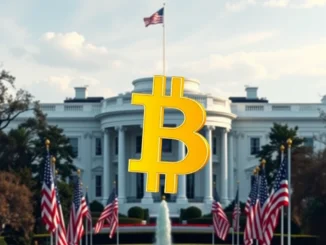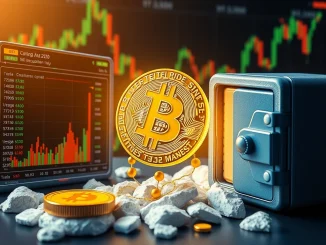
In the ever-exciting world of cryptocurrency, where fortunes are made and narratives shift in the blink of an eye, a prominent voice has once again stirred the pot. Plan B, the enigmatic analyst known for his stock-to-flow model, has dropped a bombshell on X (formerly Twitter): Bitcoin, he argues, is undervalued when stacked against the traditional titans of wealth, gold and real estate. For crypto enthusiasts and investors alike, this is more than just market chatter; it’s a potential signal flare in the vast ocean of digital finance. Let’s dive deep into Plan B’s analysis and unpack what this could mean for the future of Bitcoin and your investment strategy.
Is Bitcoin Truly Undervalued Compared to Gold and Real Estate? Plan B Thinks So.
Plan B, a figure shrouded in pseudonymity but respected for his market insights, recently took to social media to lay out a compelling case. His core argument? Bitcoin’s current market capitalization of $2 trillion pales in comparison to gold’s colossal $20 trillion. He further bolsters his point by comparing the scarcity, or stock-to-flow ratio, of these assets. Bitcoin boasts a stock-to-flow ratio of 120 years, doubling gold’s 60 years. But what do these numbers really mean, and why should you care?
Let’s break down Plan B’s perspective step-by-step:
- Market Capitalization Discrepancy: Bitcoin’s $2 trillion market cap is just a fraction of gold’s $20 trillion. This tenfold difference is the cornerstone of Plan B’s undervaluation argument.
- Scarcity Advantage: Bitcoin’s stock-to-flow ratio of 120 years surpasses gold’s 60 years. This suggests Bitcoin is becoming scarcer at a faster rate than gold, potentially driving up its value over time if demand remains constant or increases.
- Digital Gold Narrative: Plan B’s analysis implicitly reinforces the narrative of Bitcoin as “digital gold.” By comparing it directly to gold, he positions Bitcoin as a modern, technologically advanced store of value.
But is it really that simple? Is Bitcoin genuinely undervalued just because its market cap is smaller than gold’s? Let’s delve deeper.
Market Cap Showdown: Bitcoin vs. Gold and Real Estate Giants
Market capitalization, or market cap, is essentially the total value of an asset in the market. It’s calculated by multiplying the current price of an asset by the total number of coins or shares in circulation. When Plan B points out the stark difference in market cap between Bitcoin and gold, he’s highlighting a significant gap in perceived value by the market as a whole.
Consider this table to visualize the scale:
| Asset | Estimated Market Cap (USD) |
|---|---|
| Gold | $20 Trillion |
| Real Estate (Global) | $300+ Trillion (estimated) |
| Bitcoin | $2 Trillion |
As you can see, Bitcoin’s market cap is dwarfed not only by gold but even more so by the global real estate market. This raw data fuels the argument that Bitcoin has significant room to grow if it’s to truly compete with these established asset classes as a store of value or investment.
Decoding Scarcity: Stock-to-Flow Ratio and Bitcoin’s Edge
The stock-to-flow (S2F) ratio is a metric used to quantify the scarcity of a commodity. It’s calculated by dividing the total stock (existing supply) by the annual flow (new production). A higher S2F ratio implies greater scarcity, as it indicates a larger existing stock relative to the new supply entering the market. Plan B is a strong proponent of the S2F model, and he uses it to argue for Bitcoin’s long-term value proposition.
Let’s break down the scarcity argument:
- Bitcoin’s High S2F: With an S2F of 120 years, Bitcoin’s new supply entering the market each year is relatively small compared to its existing supply. This is due to its programmed, decreasing block reward halving schedule.
- Gold’s S2F: Gold’s S2F of 60 years is also high, reflecting its scarcity. However, Bitcoin’s ratio is double, suggesting it’s becoming scarcer at a faster pace.
- Impact on Value: Scarcity is a fundamental driver of value. If demand for an asset increases or remains constant while its supply growth slows down, basic economics dictates that the price should rise. Plan B believes Bitcoin’s superior scarcity, as indicated by its higher S2F, positions it for significant price appreciation in the future.
However, it’s crucial to remember that the S2F model is not without its critics. Some argue that it oversimplifies market dynamics and doesn’t account for factors like demand shocks, regulatory changes, or technological disruptions.
Real Estate and Bitcoin: Comparing Apples and Oranges?
While Plan B directly compares Bitcoin to gold in terms of market cap and scarcity, the comparison with real estate is slightly different. Real estate is a vastly different asset class, characterized by:
- Illiquidity: Real estate is generally less liquid than Bitcoin or gold. Buying and selling properties can be a lengthy and complex process.
- Tangibility: Unlike Bitcoin, real estate is tangible and provides utility (housing, commercial space).
- Local Markets: Real estate values are heavily influenced by local market conditions, whereas Bitcoin operates on a global scale.
Despite these differences, the inclusion of real estate in Plan B’s analysis serves to highlight the sheer scale of traditional wealth compared to the relatively nascent Bitcoin market. It underscores the potential upside for Bitcoin if it continues to gain adoption as a mainstream asset.
Unlocking Potential: Why Bitcoin’s Undervaluation Could Be a Massive Opportunity
If Plan B’s analysis is correct and Bitcoin is indeed undervalued relative to gold and real estate, what does this mean for you? It could represent a significant investment opportunity. Here are some key takeaways and actionable insights:
- Potential for Growth: The gap in market cap suggests Bitcoin has considerable room to grow if it continues to capture a larger share of the store of value market.
- Diversification: Considering Bitcoin as a potentially undervalued asset could be a compelling reason to diversify your investment portfolio beyond traditional assets like stocks and bonds.
- Long-Term Perspective: Plan B’s analysis is rooted in long-term trends and scarcity. It reinforces the idea that Bitcoin is a long-term play, not just a short-term speculative asset.
- Risk Assessment: While the potential upside is significant, remember that cryptocurrency investments are inherently risky. Market volatility, regulatory uncertainty, and technological risks are all factors to consider.
Actionable Insight: Do your own research. Don’t solely rely on any single analyst’s opinion. Explore Bitcoin’s fundamentals, understand the risks involved, and consider if it aligns with your investment goals and risk tolerance.
Conclusion: Is Bitcoin Poised for a Massive Revaluation?
Plan B’s assertion that Bitcoin is undervalued compared to gold and real estate is a provocative and thought-provoking argument. By highlighting the stark differences in market cap and emphasizing Bitcoin’s superior scarcity, he paints a picture of a digital asset with immense untapped potential. While the future remains uncertain and market predictions are never guarantees, Plan B’s analysis serves as a powerful reminder of Bitcoin’s relatively small footprint in the global financial landscape. Whether you’re a seasoned crypto veteran or a curious newcomer, understanding these comparisons is crucial for navigating the evolving world of digital assets and making informed investment decisions. The question isn’t just whether Bitcoin is undervalued, but what *you* will do if it truly is on the cusp of unlocking its massive potential.



